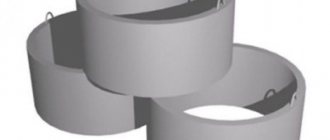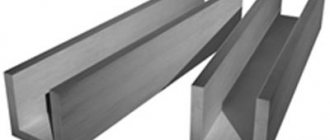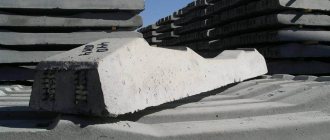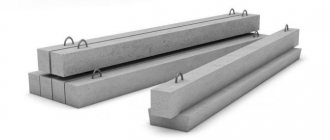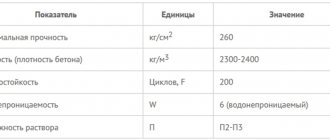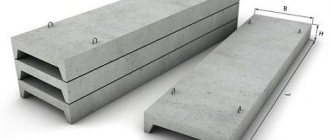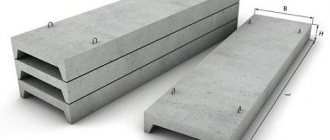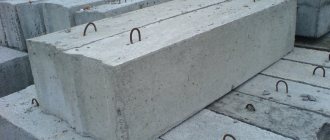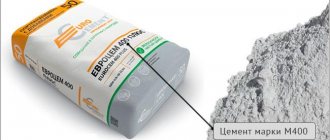To create sewerage systems in private and urban construction, concrete well rings of various designs are used. A concrete well ring is a reinforced concrete product that is used for the installation of underground utilities. Rings for concrete wells are reinforced with steel reinforcement to increase strength and withstand loads. High-quality wells are made from dense grades of concrete; the grade for drinking water wells should be selected especially carefully.
What are trays for?
The essence of the operation of drainage systems is the timely removal of precipitation and melt water accumulating on the road surface. For this purpose, the road surface is given a transverse and longitudinal slope, and storm drains are installed in the right places. Through these drainage pits, water enters a complex channel system consisting of drainage trays, stop blocks and other elements. The water diverted through these channels is discharged into acceptable locations, such as into the local river system.
If you neglect to organize high-quality drainage, sediment and melt water will accumulate on the road. And this is fraught with the destruction of road pavement and erosion of the roadbed, which in turn will lead to a rapid cessation of the functioning of the road.
How to calculate the volume of reinforced concrete rings
In order to determine the volume of sewer well rings, you should use a special table of the ratio of sizes and volume indicators.
Here you can see such indicators as the internal diameter of the product, its wall thickness, and volume.
Accordingly, in order to determine which reinforced concrete rings are needed for sewerage, you first need to calculate the total volume of the well.
Table of reinforced concrete rings
Calculations will be carried out using a very simple formula.
Here you need to multiply three indicators:
- the number of people permanently living in the house. Let's take 5 for example;
- daily water requirement per person in liters. Today this figure is 200 liters;
- the number of days during which the wastewater is completely processed. This is 3 days.
Reinforced concrete rings for 3 cubic meters together
Thus, by making a simple calculation: 5*200*3, we get 3000 liters.
Converting this figure into cubic meters, we get 3m 3.
This is exactly the volume that a sewer well should have for a family of 5 people.
Calculation of internal volume
The internal volume of the ring is calculated using a simple formula. Here you need to multiply R 2 - the radius by the height of the product and by 3.14 - a constant value.
Accordingly, to obtain the radius of the ring, we need to perform the calculation in reverse order.
We divide the total volume by 3.14 and the height of the well, which in our case is 2.3 meters with a total depth of 2.5 meters.
This gives the formula: R 2 =3/2.3/3.14. As a result, the radius will be 0.65 m.
It turns out that the diameter of the sewer well should be 1.3 m. Such products are not produced, so we take rings with a diameter of 1.5 m.
Pros and cons of reinforced concrete rings
Concrete is convenient due to the following characteristics:
- Sizes – wide choice of models.
- Concrete grades and additives can be selected so that they can withstand high loads, humidity and freezing.
- The products do not require special treatment or care.
- Long service life - up to 100 years.
- Easy to install.
- It is possible to produce concrete components directly on site on your own.
- Low cost.
The disadvantages may be:
- Large section weight.
- The need to use a crane during installation.
- If installed incorrectly, it will be difficult to waterproof the connections.
- Problems with dismantling and replacing sections.
General information
Types of networks
A sewer network is a communication with different branches, which consists of different pipes and represents one whole.
This system is necessary for transporting wastewater from users to specialized containers in which water is processed and purified.
There are two types of sewer networks:
- Internal;
- Outdoor.
Pipes and treatment systems that are located on the street refer to the external type of sewer networks. And the pipes that are located inside houses are classified as internal.
In such communications, wastewater is transported both under pressure and by gravity.
Therefore, all sewerage pipelines are divided into:
- Non-pressure;
- Pressure.
Gravity pipelines of sewerage systems are installed at an angle to ensure the movement of wastewater to the final point. For the installation of free-flow sewerage, polyethylene pipes are used.
Pressure sewer networks operate according to this principle: the pump builds up pressure and, under its action, wastewater is discharged. For pressure pipelines, pipes of good strength are used, this is necessary so that they can cope with pressure.
Also, sewer systems, depending on the purpose, are divided into the following types:
- Storm sewers (discharging melt and rain water);
- Production;
- Economic and household.
- Storm drainage is needed to remove rain and melt water.
Household sewerage is divided into two types:
- Autonomous (local);
- Central (main).
The central type of sewer system removes sewage from houses in a city area or populated area, and an autonomous sewer system serves only one house (in isolated cases, several houses).
The method of installing external sewers is divided into:
- Separate;
- General alloy;
- Semi-separated.
External sewer networks
There are several types of sewer networks that are laid externally.
Trace. This design is installed from a point to a specialized tank. Tracing is also installed in an apartment building (observing all building rules and regulations). Pipes are laid only vertically. The distance from the outer wall of the building to the communications must be at least three meters. Trace installation is carried out only when there are connections to the central sewerage network.
External sewerage consists of pipes, wells and collectors.
Sewage network located on the street. This system consists of a complex system of wells and pipes. It is done on the streets of the city. Through street sewer networks, wastewater moves to the central sewerage system, and then to treatment systems.
Collectors. These devices are designed to collect sewage and redirect it if necessary. Sewage is redirected from collector to collector, which is located near the sewerage basin or on its territory. The work of the collector is to transport wastewater by gravity or under pressure.
Treatment buildings are the final destinations for sewage. These facilities concentrate and purify wastewater. After the water is purified, it is discharged into reservoirs and then used for economic purposes.
The laying of sewer networks takes place in different ways because it depends on specific cases.
Making rings at home
If it is impossible to purchase ready-made products (for example, transporting them is far away and expensive), you can make the rings yourself. To do this, you need to prepare the ingredients for concrete and materials for assembling the formwork.
Concrete
To prepare concrete M200 (B15) you will need:
- Portland cement PC500 D0 – 1 part;
- Medium fraction sand, cleared of impurities and clay – 4 parts;
- Small crushed stone fr. 5-10 mm – 4-5 parts;
- Water – 0.5-0.7 parts of the volume of cement;
- Plasticizer C3 – no more than 7% by weight of cement.
The plasticizer is added to water until completely dissolved. You should not refuse to use the additive - with its participation, the working concrete solution is plastic and workable. Bringing it to the required condition with water is fraught with loss of strength and premature destruction of the walls of the well.
It is convenient to measure parts in buckets. The components must be mixed in a self-contained concrete mixer.
Frame
The reinforcing frame of the concrete ring consists of main parts - horizontal belts made of periodic reinforcement 8-12 mm and vertical connecting clamps made of wire d = 6-8 mm.
- Horizontal belts must be solid, that is, their ends must be welded. The distance between the rods in the frame should be 20-30 cm.
- Vertical rods tie horizontal belts. The elements should be connected using a binding wire. The distance between the vertical rods is 30...40 cm.
- Mounting loops made of 8-10 mm reinforcement should be welded to the upper horizontal belt.
Formwork
The most difficult thing in preparing for the manufacture of reinforced concrete rings is creating a mold for pouring them. There are several formwork options:
- Use sheet metal 3-8 mm thick. The method takes place if there is equipment for bending workpieces. The ends of the sheets are connected to each other, for example, with window hinges, which can later be removed and the metal reused for other purposes. Spacers are placed along the top of the form to ensure the rigidity of the formwork. You will need to make 2 molds with a diameter difference of 3-4 cm.
- Using thick-walled metal barrels is similar to the previous method. The containers must also differ in diameter; they must be cut lengthwise and connected with a detachable connector to be able to remove the mold from the finished concrete.
- Wooden formwork will not give an ideal round shape; rather, it will turn out to be a polygon in cross-section. Boards or construction plywood need to be cut into narrow strips with a jigsaw and made into a circle. Metal ties from below and above will help to fix their position: for external formwork along the outer diameter, for internal formwork the strips are placed on a clamp along the inner diameter for easy removal.
Compound
The frame is inserted into the formwork, centered in the center, and the binding wire will help fix the position. Then the finished concrete is poured and left to harden. You can remove the form after 2-3 weeks.
Problems and difficulties in designing external and internal networks
The main difficulties in preparing sections of the project for utility networks are associated with the following points:
- with the restrictions specified in the technical specifications for connection;
- lack of technical capability to connect the facility to general networks, the need for serious additional costs for connecting communications;
- poor condition of current networks and equipment, they need to be replaced and restored;
- the need to strengthen building structures for the installation of internal or external networks.
To avoid difficulties during design and coordination, contact only ]Smart Way.
How to install concrete rings
The installation process for water supply wells, sewer septic tanks and telephone shafts is different. For some, a reinforced concrete cover is placed at the bottom of the pit, for others, a thick layer of sand and crushed stone is poured, which acts as a filter.
If we talk about the direct installation of the rings, the work algorithm looks like this:
- The first ring is mounted on the prepared base (bottom or bulk platform). It is aligned vertically.
- Next, on the plane on which the next ring will be installed, it is necessary to lay a sealant - cement mortar or rubber pads. They should be laid even if there is a locking connection.
- Subsequent rings are laid in the same way.
The upper rim is crowned with a lid with a hatch - they should rise above the ground by at least 30 cm.
Installation Features
Concrete well rings should be immediately sealed from the outside. Special impregnations and coatings based on polymers will help with this; you can also plaster the walls with a modified cement-sand mortar with additives. The seams are treated from the inside with the same solution; there is no need to treat the entire walls.
To avoid deformation of the walls of the well, when installing reinforced concrete rings, it is advisable to lay the outer walls with crushed stone, which will serve as a load compensator and drainage.
Recommendations for selection
The shaped element for sewerage is selected according to the following criteria:
Material of manufacture. It is desirable that it completely matches the type of pipes used to lay the collector. Internal section of products. It must correspond to the diameter of the pipes: if the collector has a cross-section of 110 mm, the outlet for sewer pipes is taken with a diameter of 110 mm, no more and no less. Availability of rubber seals. They greatly facilitate the sewer installation process. Product compliance with GOST. As a rule, there is a corresponding marking on the outside of the product. Bend angle
It is important to correctly calculate the line configuration in order to avoid errors when arranging its direction. The presence of a flat, smooth inner surface of the product. Otherwise, in the future, wastewater with large inclusions will provoke the formation of growths on the walls of the collector.
Calculation of the volume of concrete for the production of reinforced concrete rings
The product manufacturing procedure complies with GOST standards. Any deviations from the requirements lead to a decrease in product quality, violation of the specified technical characteristics and minimization of service life during operation. For the mixture from which the rings for the reinforced concrete well are cast, the following components are used:
- sandy clean mixture;
- gravel;
- fine crushed stone;
- heavy grade cement M400, M500;
- iron fittings.
It is important to maintain the ratios of all components. In particular, for a 2.4 t concrete batch, the parameters of other components are as follows:
- 150 kg of clean river sand or mixture;
- 300 kg of cement (it is better to take the specified grades so that the concrete base is stronger);
- 1200 kg of crushed stone;
- 150 liters of water.
An important parameter: the ratio of water and cement should not be greater than 0.7 in calculations. Otherwise, the strength and toughness characteristics will be significantly reduced. Only by carefully calculating how many components to take for the manufacture of reinforced concrete rings for wells can you obtain a high-quality product.
Fittings for plastic pipes
PVC sewerage fittings
A fitting is the part of the pipeline needed to connect a pair of pipes at an angle, in the case of joining more than two pipes, etc.
The fittings also allow you to connect the local sewer system to the city main.
Where are fittings used? Most often they can be found during the installation of sewage systems in residential buildings, and these can be both residential buildings in the city and beyond, and in high-rise apartments. The fittings can be used in systems through which wastewater passes at a temperature of no more than 80° C, as well as for the removal of short-term wastewater at a temperature of 95° C. The drainage is intended not only for dirty water from a sink, toilet or shower stall, but also for certain chemical compositions, the coefficient of which, recognizable as pH, has a spectrum from 2 to 12.
Types of fittings
Fittings for external and internal sewerage
According to their type, fittings can be as follows:
- those that are used in systems installed inside the house;
- those used in systems outside the home.
The method of connecting fittings is also different and can be done using a rubber gasket in the form of a ring and, in rare cases, by gluing.
The O-ring is not used as a last resort.
Design and preparatory stage
When drawing up a sewerage project correctly, you need to find out:
- is it possible to connect the building to centralized networks;
- how waste will be disposed of in an autonomous system;
- what volume of wastewater will be produced daily;
- whether the private house will be in constant use;
- to what depth the soil freezes, and what is the groundwater level in the area.
Sewerage and water supply projects are developed jointly. An integrated approach allows you to avoid mistakes and make sewerage as efficient as possible. The document states:
- General data containing the name of regulations and the composition of the project. This section contains an explanatory note for the installation of water supply and sewerage systems.
- Explication of premises - contains a plan of all floors indicating wet areas and instructions for their waterproofing.
- Calculation of water consumption and wastewater disposal. The section provides the relevant standards and makes calculations taking into account a specific building - apartment or country house.
- Plumbing plan - contains the exact location of plumbing fixtures.
- Sewerage diagram - it shows the routes for laying pipes, indicating their sizes and the location of the risers.
- A specification that identifies the required equipment, fasteners, pipes and fittings.
The preparatory stage before sewerage consists of the following steps:
- Decide on the number of plumbing fixtures and their location.
- Provide the possibility of installing additional equipment that will require installing a sewer drain. To do this, it is necessary to install a closable outlet with a plug.
- After calculating all the parameters, cut the pipes, taking into account the parameters of the fittings. For plastic products, you can use a hacksaw. The cut must be made at a right angle. After the procedure, the edges should be cleaned with a knife or sandpaper.
- The installation of the sewer pipeline must be carried out at a slope, for which special brackets are used.
Types of rings for wells
Since wells can be sewer, gas, or built specifically for water supply systems, the elements and components for constructing such wells differ in their purpose.
There are the following types of concrete rings:
- Reinforced concrete . They are intended for the construction of utility networks (drainage and sewer wells, water supply and gas pipeline systems, laying underground network cables).
- Additional ones . They are used when standard ones do not fit in size.
- Supporting . They are laid at the base of the well.
- Wall . With their help, the neck of the well is constructed; The main area of application is installation in confined spaces.
- Collectors.
Types of concrete rings for wells.
In addition, complementary products with a lock and a bottom, with a floor slab and prefabricated ones, as well as round and square rings are produced. Manufacturers produce elements equipped with grooves for fixation. This is necessary so that in the event of displacement, the well constructed from such rings does not collapse.
The advantages of concrete rings include durability, strength, speed of installation of engineering systems, a wide range of sizes and rigidity of the structure. In addition, the dense structure of the material increases the tightness of the rings.
Among the disadvantages are their dimensions and large weight, as a result of which the price of their transportation and installation increases, since it is impossible to do without the use of special equipment.
The main stages of installing a sewer well
The construction of a sewer well made of concrete rings is technologically simple; difficulties arise only due to the large weight of the products. You can install them in your dacha with your own hands, without involving equipment. They use the old method of digging under the rings. Only the wall rings are deposited, and if a bottom is required, they are filled in independently.
Choosing a location for a septic tank
For containers, you need a small area, remote from other objects. According to sanitary and building standards, distances must be no less than the specified values:
- from the house – 5 m;
- to public roads – 5 m, access roads – 3 m;
- from the well – 30 m;
- from the border of the neighboring plot - 3 m;
- to the reservoir - 20 m.
When designing the location, take into account that equipment access is required. They try to choose a larger distance to the playground, summer kitchen, and swimming pool. Even with the most perfect ventilation, anaerobic septic tanks still emit an odor.
Installation
The order is:
- dig a pit of the required depth, the diameter is larger than the rings;
- a concrete slab is laid at the bottom of the pit or a foundation is poured;
- lower the rings while simultaneously waterproofing the joints;
- a ceiling is installed on top;
- install a drain pipe.
Effluent from the septic tank should not seep into the ground. For additional sealing of joints, cement with additives that increase strength is used.
For a drainage well, this is not so important: its purpose is to drain wastewater into the soil, it is no longer so dirty. The bottom ring can be installed with holes in the finished product. Lockless well rings are still seated on the mortar so that the structure does not move under soil pressure
Lockless well rings are still seated on the mortar so that the structure does not move under soil pressure.
The filtration well is built in the following sequence:
- pour sand 0.5 m high from the bottom of the pit;
- on top – 20 cm of gravel;
- install rings, overlap;
- if the lower ring is perforated, the space between it and the ground is covered with crushed stone;
- The wells are connected with an overflow pipe.
Necks with lids are installed above the ceilings. The hatch is necessary for periodic inspection of septic tanks. The structures are covered to the top with earth so that the neck with the lid rises 10-15 cm above the surface.
Filter well design
Types of sewer pipes
Sewage pipelines are made of metal, polymers, ceramics, concrete and asbestos.
Steel pipes are durable and can be used at any temperature. The advantages are negated by susceptibility to corrosion. They are now rarely used in private homes.
Cast iron is more expensive than steel pipes, heavier, but less corrosive. Sometimes they are now made into risers, external conclusions. They are heavy and difficult to seal. Dirt is deposited on rough inner walls, reducing permeability.
Polymer sewer pipes have smooth walls, which ensures maximum throughput. Depending on the material, they are divided into several groups:
Different shapes of PVC pipes
- polyvinyl chloride (PVC);
- from unplasticized polyvinyl chloride (UPVC);
- polypropylene (PP);
- polyethylene (PE).
PVC products are used for internal and external non-pressure sewerage. They are not affected by ultraviolet radiation and have sufficient strength. In everyday life, SN2 is used if the system is laid at a shallow depth and does not cross roads. SN4 is used when it is necessary to lay a pipe under a road with a light load, for example under the entrance to a garage. PVC is not resistant to temperature changes and aggressive substances; it burns, releasing toxic gas.
Polypropylene is recommended to be used only for internal sewerage, as it is soft and easily deformed under load. It can withstand high temperatures and has a long service life. PP products are environmentally friendly and resistant to aggressive substances.
Sewage polypropylene pipes of various diameters
Polyethylene pipes are not recommended for use in sewers with hot wastewater above +40°C - expansion and elongation occur. Withstands frosts down to -40°C. Low-density polyethylene has higher qualities:
- withstands temperatures down to -70°C;
- resistant to water hammer;
- does not change size with increasing temperature.
There are some disadvantages: HDPE has low strength, external sewerage is located only underground. It is afraid of ultraviolet radiation and cannot withstand high temperatures.
Ceramics are used in industrial systems: they are fragile and difficult to install. In everyday life, asbestos and concrete pipes are sometimes used to install short-distance lines.
Ring prices
The pricing policy is determined by the market, and therefore in different regions the same product will cost differently, but everywhere its price is directly dependent on the size. And if for KS 7.3 you will have to pay from 700 rubles, then for KS 20.9 - already about 4.5 thousand rubles. Purchasing from the manufacturer provides savings of 5-15% compared to construction markets. But when drawing up an estimate, in addition to spending on rings, the customer must keep in mind other expenses:
- digging a foundation pit for a structure;
- for delivery of products;
- for installation work;
- construction of a well house (optional);
- for additional materials, for example, cement for sealing joints or pebbles for the filtration bottom of a well.
It makes sense to cooperate with one supplier. In many cases, this will bring additional benefits in the areas of service, delivery and information support.
What else do you need to buy?
In addition to the rings themselves, to install a water supply, sewerage or gas pipeline system, it is necessary to purchase additional elements, such as:
- bottom - the bottom slab will provide a solid foundation for the well;
- overlap - this element is designed to install a smaller ring on a larger one;
- additional product - it allows you to increase the height of the well with less weight.
Additional elements have a standard diameter, but smaller wall thickness, and can be used as upper components for a well, for example, a ring with a lid. Additional elements will help ensure the tightness of the structure and protect the pipes from freezing in the winter.
Types of fittings for the installation of internal sewer systems
Fittings are parts thanks to which docking units, turns, branches are mounted, and pipes of different diameters are connected into a single network. During wiring, the presence of all kinds of fittings allows you to create complex shapes of structures from straight components.
The shaped parts, as well as the pipes of the internal sewage system, are made of gray PVC. Currently, the following types of fittings are used in construction:
- double-socket coupling - a part that connects sections of pipes of equal diameter that do not have a socket in one line without bends;
- Slide-on repair coupling - a part for eliminating emergency situations and various damage to the pipeline (leaks, cracks, breakdowns). Convenient for repairs in a section of the system where it is necessary to remove part of the damaged line;
- inspection coupling – a connection element with three inputs, the central input (hole) is equipped with a screw cap. By opening the lid, you can clean clogged pipes. Placed in a place where there is convenient access;
- compensation pipe - a piece of pipe 17-25 cm long, on one side it has an elongated socket, on the other - a smooth part, which is attached to the pipeline with a connecting coupling. Designed to increase the length of pipes and replace damaged sections;
- an adapter between two pipes of different diameters, called a reduction - an eccentric coupling, where the bell part goes for the large diameter, and the coupling part for the small one;
- cast iron/plastic adapter - used to connect cast iron sewerage to plastic, has a bell-shaped inlet with a diameter suitable for a cast-iron pipe and a coupling;
- elbow or elbow – curved 15-90 degrees. a part with a wide selection of diameters for designing sewer pipe bends;
- tee - a Y or T-shaped fork used to connect one branch to the main pipeline. An additional entrance with a bell may have equal or smaller dimensions;
- cross - an element for connecting two bends to the main pipe in the same plane, and the diameters of the bends can be different from the diameter of the main riser;
- two-plane cross - a connecting point in which two branches are connected on the left or right side perpendicular to the main pipe;
- a cover for blocking the end of the pipeline or a plug blocks the movement of drains;
- vacuum valve (aerator) – prevents the release of dangerous sewer gases into the room through installed plumbing fixtures due to vacuum in the system, mounted at the top point of the riser;
- exhaust hood - an element of aeration of the riser in the form of a plug with holes, prevents the ingress of debris and precipitation;
- siphon - an element connecting the outlet and plumbing. Its curved shape creates a water seal that holds back waste odors;
- clamp – pipe mounting fastener.
The range of fittings is very wide, you can choose a part to solve any problem
The connection of PVC fittings to pipes can be glued, welded (soldered), threaded (drain with a small diameter, for example a sink) and using a rubber ring. Whatever type of connection is used, you need to remember that the joint is the most critical place in the installation of a sewer system. The operation of the entire system depends on the quality of the joining of fittings, so you should carefully consider this issue or contact a specialist.
The shaped parts for internal sewerage are equipped with a rubber sealing ring, which, when assembling the network, ensures a reliable, tight connection. However, there are recommendations to strengthen this type of connection with silicone sealant to prevent the rubber from drying out. The sockets without a rubber layer are connected using glue. When hardened, the structure of the glue becomes similar to PVC with the same characteristics as pipes.
Before joining the fittings, pipes and plumbing must be carefully secured to avoid disruption during the assembly process and possible leaks.
Concrete rings for sewerage: sizes, prices and varieties
In private and suburban construction, sewer systems based on concrete rings are often used. This type of sewage system is considered one of the most economical. After all, the price of concrete rings for sewerage is low, and the process of their installation does not require a lot of time. As a result, the owner of a summer cottage has the opportunity to create comfortable conditions for living outside the city.
Concrete ring with a solid bottom
Along with bricks and polymer rings, concrete elements are also used for the construction of sewage systems in the country without pumping. Each of these materials is characterized by its own advantages and disadvantages, however, concrete structures significantly exceed the parameters of other system options.
Brick is less durable and requires a significant amount of time to make masonry, in contrast to ready-made elements that just need to be placed on the bottom of the pit and fixed. In addition, it is extremely difficult to make deep wells based on brickwork. The turnkey price of a sewer system made of concrete rings is not much higher than the cost of manufacturing a brick system. Taking into account the simplicity of installation work and the minimal time spent, such a small overpayment is completely justified.
Prices for turnkey installation of sewerage from concrete rings:
| Number of rings | Capacity, m³ | Number of consumers | price, rub. |
| 3+2 | 3,5 | 1-3 | 35990 |
| 3+3 | 4,2 | 2-4 | 39990 |
| 4+2 | 4,2 | 3-4 | 39900 |
| 4+3 | 4,9 | 3-5 | 45990 |
| 4+4 | 5,6 | 4-6 | 49900 |
| 3+3+3 | 6,3 | 4-6 | 59990 |
| Installation of a septic tank in areas with high groundwater levels | |||
| 2+2 | 2,8 | 1-2 | 30990 |
| 2+2+2 | 4,2 | 3-4 | 43990 |
Advantages and disadvantages of using concrete wells for sewerage
Many summer residents prefer to buy concrete rings for sewerage for arranging a system on their summer cottage; the prices of these products are far from the only advantage that confirms the benefits of such a purchase.
Advantages of concrete structures:
- the possibility of installation in areas with any type of soil (due to the increased safety factor, concrete rings are able to withstand the natural pressure that is formed during the displacement of groundwater or seasonal movement of soil);
- it is possible to use any materials to perform waterproofing;
Concrete ring for sewerage with stairs
- even if you plan to do the installation work yourself, this process will not take too much time;
- due to the smooth internal surface, the speed and quality of cleaning concrete wells increases;
- the material is more accessible than brick or stone;
- long service life without the need for repair work.
A wide variety of sizes and prices of concrete rings for sewerage allows you to create septic tanks of any capacity and depth. This type of material is highly hygroscopic, so contaminated wastewater can partially seep through the walls into the surrounding soil. However, this problem can be easily solved with waterproofing.
Main types and general sizes of sewer rings
There are two types of concrete products for sale for sewer construction:
- Additional (from 670 rub.).
- Wall (from 990 rub.).
Wall sewer rings
Wall-type elements are used to form the neck of the structure. Additional product options have an expanded range of sizes, and non-standard ones. They are used in cases where the height of storage tanks according to the project cannot be formed from elements with standard dimensions. With the help of additional rings, you can adjust the height of any septic tank structure.
Concrete rings used for the construction of country sewer systems are elements of a regular round shape. The internal diameter of the products ranges from 70 to 200 cm. The standard wall thickness is 70-100 microns. Most often, for the manufacture of drainage pits and country septic tanks, a size of 1-1.5 m is used; the price of concrete rings of this diameter is 1500-2500 rubles. per product.
To make rings, manufacturers use metal reinforcement and grades of concrete with different characteristics. Metal, as a reinforcing component, increases the strength of products and reliability. In addition, the possibility of stretching a structure made of rings is eliminated. In turn, concrete provides corrosion protection to the metal. As a result, the septic tank design is not subject to deformation changes under the influence of compressive loads.
Dimensions of wall concrete rings
Choose the right concrete rings for the well or make it yourself
Reinforced concrete is a durable, moisture-proof, acid- and alkali-resistant material.
It effectively protects its contents from penetration into the surrounding soil. It is possible to make concrete parts for a well yourself on site. In some cases, costs (reinforcement, formwork, mixture, installation) will be less than the cost of purchasing and transporting an industrial product.
Types and characteristics of concrete rings
Reinforced concrete rings in accordance with GOST 8020-90 are made of concrete grades M200 or M500, using reinforcement with a diameter of up to 10 mm, made of steel class At-IIIC, At-IVC (GOST 10884) and A-I, A-II, A-III ( GOST 5781), as well as BP-I wire (GOST 6727), with a cross-section of at least 0.6 mm. In everyday life, when constructing sewer wells, the following types of rings and auxiliary elements are used:
KS - wall rings in accordance with GOST 8020-90 have an internal diameter from 700 to 2500 mm, a height from 290 to 1190 mm, the thickness of their walls is in the range from 70 to 100 mm. Products are produced both with smooth ends and with protrusions for installation with a locking connection. It is allowed to increase the dimensions of concrete rings for sewerage in height in increments of 300 mm up to a value of 1790 mm.
Rice. 6 Parameters of PP floor slabs
KO - support rings installed on top of the structure to create a low neck, which is then covered with a hatch. Concrete rings for KO sewerage specified in the standard have a single standard size with an internal diameter of 580 mm, a wall thickness of 130 mm and a height of 70 mm.
In contrast to the requirements of GOST 8020-90, commercial companies supply the market with a wide range of support rings of various sizes (they are also called additional rings), many of them are used for installing high necks intended for organizing manholes into chambers. Some products have a more complex configuration with an expanded support part and a narrowed neck.
KCP - rings with a poured overlap on top, have a round or rectangular opening of standard sizes for penetration into the chamber.
KCD is a concrete ring with a bottom for sewerage, has the dimensions of a standard KS, convenient for constructing caisson wells, septic tanks, closed settling tanks, underground sealed tanks (cellars, vegetable stores).
PN and PP - bottom slab PN (too often you can find its incorrect designation PD (according to GOST 8020-90 PD is a rectangular road slab with a hole)) and the upper floor slab PP, which has a round or rectangular hole offset to the edge.
According to GOST 8020-90, PN slabs are produced in three standard sizes with outer diameters of 1500, 2000 and 2500 mm and thicknesses of 100 and 120 mm. The symbol indicates the internal diameter of the wells in decimeters under which they are placed - PN 10, PN 15 and PN 20.
PP floor slabs with holes have standardized internal dimensions, designed to cover wells with diameters from 1000 to 2500 mm, their external dimensions range from 1160 to 2700 mm. The width of round manholes is 700 and 1000 mm.
PO – square support plate with dimensions 1700x1700 mm, thickness 150 mm and a hole with a diameter of 1000 mm.
Rice. 7 Price list 2022 for well reinforced concrete products
Features of installation and operation
Some sizes of concrete rings are up to 70–200 kg, which allows them to be laid manually or using homemade devices. Special equipment will be needed if the additional equipment weighs 1,000–1,500 kg.
In this case, concrete rings with a lock are sealed with construction mixtures, as well as jute. If necessary, the inside is coated with a deep penetration primer, and then covered with mixtures that increase water resistance (entirely or just the joints). The simplest primer for reinforced concrete is a solution of PVA glue in water (1 to 8).
During operation, it is important to monitor the condition of the joints: they will be the first to show shifts in soil masses and the possible need for excavation work. Joints must be regularly sealed - using primer, jute, etc.
Restoration of reinforced concrete structures consists of sealing the ring with a lock and further filling the crack with concrete with pre-treatment with a deep-setting primer. If necessary, metal staples are applied to the crack.
Application of reinforced concrete rings
The scope of application of reinforced concrete rings for wells is very wide. Depending on the design features, ring-type products are divided into:
- supporting reinforced concrete products (RC) - used when making well hatches. Produced with a diameter of 820 mm and a height of 20-70 mm;
- wall elements (WE) - made with side walls for laying the middle part of water supply channels. They can have a height from 200 mm to 900 mm;
- with cover (PP) - special covering slabs of simple design with a hole for a hatch. Serve as a cover when laying simplified wells;
- with a bottom (PN) – lower support structures installed using lifting equipment. Act as supports for laying middle and top rings.
Photos of reinforced concrete production
Product dimensions: height, diameter, weight, volume in cubes
Depending on the material (concrete, reinforced concrete), its brand, height, wall thickness. The dimensions of concrete rings for wells are determined by their purpose. Below are the most applicable options for reinforced concrete structures, indicating the main parameters and weight:
| Product brand code | Purpose | Dimensions (wall thickness, material consumption) for reinforced concrete parts of the well |
| KS 7-9 | Small-diameter underground communications: sewerage, drainage, wells, gas | H = 90 cm; D = 70 cm; T (wall thickness) = 9 cm; weight – 380 kg; volume – 0.628 m3; concrete volume – 0.15 m3 |
| KS 10-9 | Pumps, caissons for fire hydrants, drinking and waste wells. Most used on private plots | H = 90 cm; D = 100 cm; T = 9 cm; weight – 600 kg; volume – 1.198 m3; concrete volume – 0.24 m3 |
| KS 15-9 | Industrial pipelines, gas and sewer wells | H = 90 cm: D = 1.5 m; T = 9 cm; weight – 1000 kg; volume – 4.31 m3; concrete volume – 0.4 m3 |
| KS 20-9 | Cesspools, storm drains, main communications | H = 90 cm; D = 2 m; T = 9 cm; weight – 1480 kg; volume – 6 m3; concrete volume – 0.59 m3 |
Pipe material
The selection of material for the installation of underground communications is one of the main points in drawing up a project for internal and external water supply and sewerage of residential buildings. It is necessary that they have good resistance to corrosion, the action of solid suspensions and the environment. SNiP considers the possibility of using the following pipes:
Selection of material
- Polyethylene;
- polyvinyl chloride;
- polypropylene;
- steel;
- cast iron;
- reinforced concrete;
- asbestos-cement;
- ceramic
- glass.
The use of the latter is permitted by regulations, but only in exceptional situations.
Reinforced concrete pipes
Used in non-pressure networks. They usually have a large diameter and are resistant to external influences, as well as compressive and tensile loads. They can be used to drain wastewater from industrial buildings, the main area of application is urban sewerage with a large volume of wastewater.
Asbestos cement pipes
Can be used not only in non-pressure networks, but also in pressure networks. The material can withstand loads well and is difficult to impact. As a result of interaction with the aquatic environment, its strength only increases.
Steel pipes, although provided for by SNiP, are rarely used for underground sewers, as they are susceptible to corrosion.
Cast iron pipes
Widely used option. For a long time, only this material was used; its service life reaches 80 years. These are very durable pipes that are not subject to corrosion. They are mainly used for laying urban networks, but are sometimes used in private construction. The disadvantages include internal roughness, which contributes to build-up of solid particles contained in the liquid, large mass of the product and high cost due to the peculiarities of cast iron production according to GOST.
Polymer pipes
They have become widespread recently. They are made of polyethylene, polyvinyl chloride or polypropylene. These products are lightweight and can withstand loads well, so they are used in pressure and non-pressure networks. The advantages also include their lightness and relatively low cost.
The main disadvantage of PVC pipes is the small range within which they retain their performance properties. They do not tolerate high and low temperatures well, so when installing PVC pipelines it is necessary to provide thermal insulation. PVC pipes are rarely used for installing external utility networks, but they perform well when installing internal water supply and sewerage systems.
How to check the size of rings for a well according to GOST
Choosing a well ring manufacturer is usually a headache. There are usually several manufacturers of different sizes. Who to give preference to? You can collect reviews from your neighbors and choose a couple of manufacturers. Then it’s worth driving around and seeing with your own eyes, because “normal quality” is different for everyone. What to look for and how to inspect well rings? This is how the same GOST defines verification.
Measurements are taken along two perpendicular diameters. This means that one of the points is selected. The second one will be located opposite it, and the other two will be located perpendicular (a straight line drawn at an angle of 90° - as in the figure).
How to check the size of a concrete ring for a well
- At four points, located in pairs opposite each other, the wall thickness is measured. Moreover, it is advisable to check this parameter from below and from above. If the rings are locking, check the parameters of the tenon/groove - they must match. And it is also necessary to control both from above and from below.
- Also at four points, check the height of the ring.
Plates and rings are checked using the same method. Four points are selected - two on perpendicular lines and measurements are taken at them. The measured values must match. Permissible deviations are no more than 1.5%.
Which ones are better and how to determine quality
There are two technologies for the production of concrete rings: vibration casting and vibration pressing. In the first case, concrete is poured into collapsible molds, compacted with a submersible vibrator and left until it sets. This usually happens after 6-8 hours. Then the molds are removed and the rings are left to “ripen” so that they gain enough strength for sale - 50%.
They can be installed in 28 days, so it’s better not to buy “fresh” rings. Another point: in the last days of ripening, cracks may appear. So it is best to purchase well rings that have been “aged” in a warehouse. As you can see, the technology is simple; apart from the forms, there is no equipment. This allows us to open small workshops that make these products. In this case, the quality depends entirely on who mixes and pours the molds.
You need to choose based on the quality of the walls and edges, the absence of defects and deviations in size
To produce well rings using vibrocompression, special equipment is required. Not only the forms, but also the brick making machine itself. It creates a certain pressure and vibration frequency at each stage of the process. The result is more uniform concrete, smooth and even edges, and a perfectly formed edge or lock. But the price is also higher - more expensive equipment.
Which manufacturer to choose
In the Russian Federation, about 250 manufacturers are engaged in the production of reinforced concrete rings, covering the entire territory of the country. Therefore, traveling outside your region in search of cheap prices is not economically profitable. The savings will be consumed by transportation. However, the products of some factories are in special demand. We can highlight:
- "VTG Stroy" in Mytishchi, Moscow region, shipping its products throughout the country. Their KS 10.9, KS 15.9 and KS 20.9 rebated and flat models complete with a lid and hatch are in particular demand. The average cost is 2.1 thousand rubles.
- OJSC "Plant of Industrial Construction Parts", operating for more than 45 years in Tyumen. It has its own accredited construction laboratory, which allows not only to monitor quality, but also to develop new technologies.
- in Novokuznetsk is a supplier of high-quality reinforced concrete products throughout the Kemerovo region. In addition to producing standard designs, the company is also willing to accept orders for individual projects.
- in Krasnodar is distinguished by a wide range and high production capacity. Prices for reinforced concrete products start from 1.4 thousand rubles.
These manufacturers strictly monitor production technology and guarantee the quality of their products.


